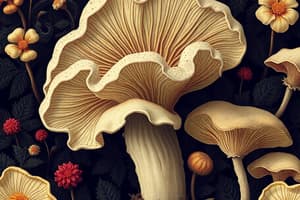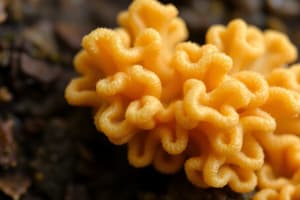Podcast
Questions and Answers
Fungi cannot make their own food like plants, which means they are classified as?
Fungi cannot make their own food like plants, which means they are classified as?
- Autotrophs
- Heterotrophs (correct)
Which of the following categories of heterotrophic fungi obtains their carbon source from the by-products of organisms or dead organisms?
Which of the following categories of heterotrophic fungi obtains their carbon source from the by-products of organisms or dead organisms?
- Parasites
- Saprobes (correct)
- Facultative parasites
- All of the above
Parasites are organisms that obtain their nutrition from the protoplasm of a host.
Parasites are organisms that obtain their nutrition from the protoplasm of a host.
True (A)
Facultative parasites are organisms that:
Facultative parasites are organisms that:
What is symbiosis, in the strict sense?
What is symbiosis, in the strict sense?
Lichens and Mycorrhizae are examples of a mutualistic symbiosis.
Lichens and Mycorrhizae are examples of a mutualistic symbiosis.
Which of the following organelles are present in fungal cells?
Which of the following organelles are present in fungal cells?
The vegetative body of a fungus is called a:
The vegetative body of a fungus is called a:
Which of the following is a unicellular form of fungus that reproduce asexually by budding or fission?
Which of the following is a unicellular form of fungus that reproduce asexually by budding or fission?
What are the collective, filamentous strands that make up the fungal thallus called?
What are the collective, filamentous strands that make up the fungal thallus called?
What is the difference between septate and coenocytic mycelium?
What is the difference between septate and coenocytic mycelium?
Which of the following is a characteristic of dimorphic fungi?
Which of the following is a characteristic of dimorphic fungi?
What are the reproductive units of fungi called?
What are the reproductive units of fungi called?
How are fungal spores produced?
How are fungal spores produced?
Fungal spores can allow the fungus to move to new food sources.
Fungal spores can allow the fungus to move to new food sources.
Fungal spores are only produced in fruiting bodies.
Fungal spores are only produced in fruiting bodies.
What is the ecological role of mycorrhizae ?
What is the ecological role of mycorrhizae ?
Lichens are a mutualistic relationship between a fungus and a bacteria.
Lichens are a mutualistic relationship between a fungus and a bacteria.
Which of the following is a characteristic of fungal hyphae?
Which of the following is a characteristic of fungal hyphae?
Fungal hyphae grow from their tips.
Fungal hyphae grow from their tips.
Which of the following is true about fungal cell walls?
Which of the following is true about fungal cell walls?
Fungi store food primarily in the form of starch.
Fungi store food primarily in the form of starch.
All fungi require water and oxygen for growth.
All fungi require water and oxygen for growth.
Which of the following is a characteristic of fungi?
Which of the following is a characteristic of fungi?
Fungi can grow almost everywhere as long as the necessary organic matter is available and the environment is not too extreme.
Fungi can grow almost everywhere as long as the necessary organic matter is available and the environment is not too extreme.
What is the estimated number of described fungal species?
What is the estimated number of described fungal species?
Flashcards
Achlorophyllous
Achlorophyllous
Fungi are unable to produce their own food, like plants, and rely on consuming other organisms for their carbon source.
Parasites
Parasites
Organisms that derive their nutrition from the protoplasm of another organism, known as the host.
Saprobes
Saprobes
Organisms that obtain their carbon source (food) from the by-products of organisms or dead organisms.
Pathogens
Pathogens
Signup and view all the flashcards
Facultative parasites
Facultative parasites
Signup and view all the flashcards
Symbiosis
Symbiosis
Signup and view all the flashcards
Mutualistic symbiosis
Mutualistic symbiosis
Signup and view all the flashcards
Eukaryotic
Eukaryotic
Signup and view all the flashcards
Thallus
Thallus
Signup and view all the flashcards
Yeast
Yeast
Signup and view all the flashcards
Mycelium
Mycelium
Signup and view all the flashcards
Hyphae
Hyphae
Signup and view all the flashcards
Septate mycelium
Septate mycelium
Signup and view all the flashcards
Septa
Septa
Signup and view all the flashcards
Coenocytic mycelium
Coenocytic mycelium
Signup and view all the flashcards
Dimorphic fungi
Dimorphic fungi
Signup and view all the flashcards
Fruiting bodies
Fruiting bodies
Signup and view all the flashcards
Heterotrophic by Absorption
Heterotrophic by Absorption
Signup and view all the flashcards
Enzymatic breakdown of substrate
Enzymatic breakdown of substrate
Signup and view all the flashcards
Diffusion back into hyphae
Diffusion back into hyphae
Signup and view all the flashcards
Hyphae
Hyphae
Signup and view all the flashcards
Cross-walls
Cross-walls
Signup and view all the flashcards
Multinucleate
Multinucleate
Signup and view all the flashcards
Hyphal growth
Hyphal growth
Signup and view all the flashcards
Mycelium
Mycelium
Signup and view all the flashcards
Mycorrhizae
Mycorrhizae
Signup and view all the flashcards
Lichens
Lichens
Signup and view all the flashcards
Spores
Spores
Signup and view all the flashcards
Fungal Spores
Fungal Spores
Signup and view all the flashcards
Study Notes
Fungal Characteristics
- Fungi are heterotrophic, meaning they cannot produce their own food. They obtain carbon from other organisms.
- Heterotrophs are categorized as either parasites or saprobes.
- Parasites derive nutrition from the living tissues of a host organism, some of which can cause disease (pathogens).
- Saprobes obtain their food from dead organisms or organic waste. Some saprobes can become parasitic if the opportunity arises.
- Fungi are achlorophyllous. This means they lack chlorophyll, the pigment that plants use to make their food.
- Fungi are eukaryotic, with membrane-bound organelles.
- Fungi exhibit a mutually beneficial relationship between each other, and with other dissimilar organisms, this is termed symbiosis. An example of this is lichens, and mycorrhizae.
Fungal Structure
- Mycelium is the collective, filamentous strands that make up the fungal thallus.
- Hyphae are the strands of mycelium and come in two types.
- Septate hyphae are divided into cells by cross-walls called septa
- Coenocytic hyphae are not divided, forming a continuous network.
- Yeasts are unicellular fungi that reproduce asexually by budding or fission.
- The vegetative body of the fungus (thallus) can be of these forms.
Fungal Nutrition
- Fungi absorb nutrients by secreting enzymes that break down complex organic materials.
- These enzymes are secreted from hyphal tips into substrates.
- The resulting broken down products are then absorbed into the hyphae.
Fungal Reproduction
- Fungi reproduce both asexually and sexually.
- Spores are the reproductive cells that allow fungi to move to new food sources and endure tough environmental conditions.
- Spores can form directly on the hyphae, inside reproductive structures. or within fruiting bodies
Mycorrhizae
- Mycorrhizae is a mutualistic relationship between a fungus and plant roots.
- Fungus benefits by receiving sugars from the plant.
- Plant benefits by receiving increased nutrient and water uptake.
- Mycorrhizae come in different forms. (like Zygomycota).
Lichens
- Lichens are a symbiotic relationship between a fungus and an alga or cyanobacterium.
- The fungus provides structure, and the alga or cyanobacterium provides food for the fungus.
- Lichens come in three types: crustose, foliose, fruticose.
General Fungal Characteristics
- Fungi are often hidden. They grow through their food source (substratum), secrete enzymes and absorb nutrients.
- Fungi exhibit indeterminate clonal growth.
- Fungi have a cell wall of cellulose and/or chitin
- Food storage is in the form of lipids and glycogen.
- All fungi require water and oxygen, but not all are obligate aerobes.
- Fungi can exist in many different habitats.
Studying That Suits You
Use AI to generate personalized quizzes and flashcards to suit your learning preferences.
Related Documents
Description
Explore the fascinating world of fungi through this quiz on their characteristics and structures. Learn about their heterotrophic nature, types of nutrition, and the unique relationships they form with other organisms. Test your knowledge on mycelium, hyphae, and the significance of fungi in ecosystems.




